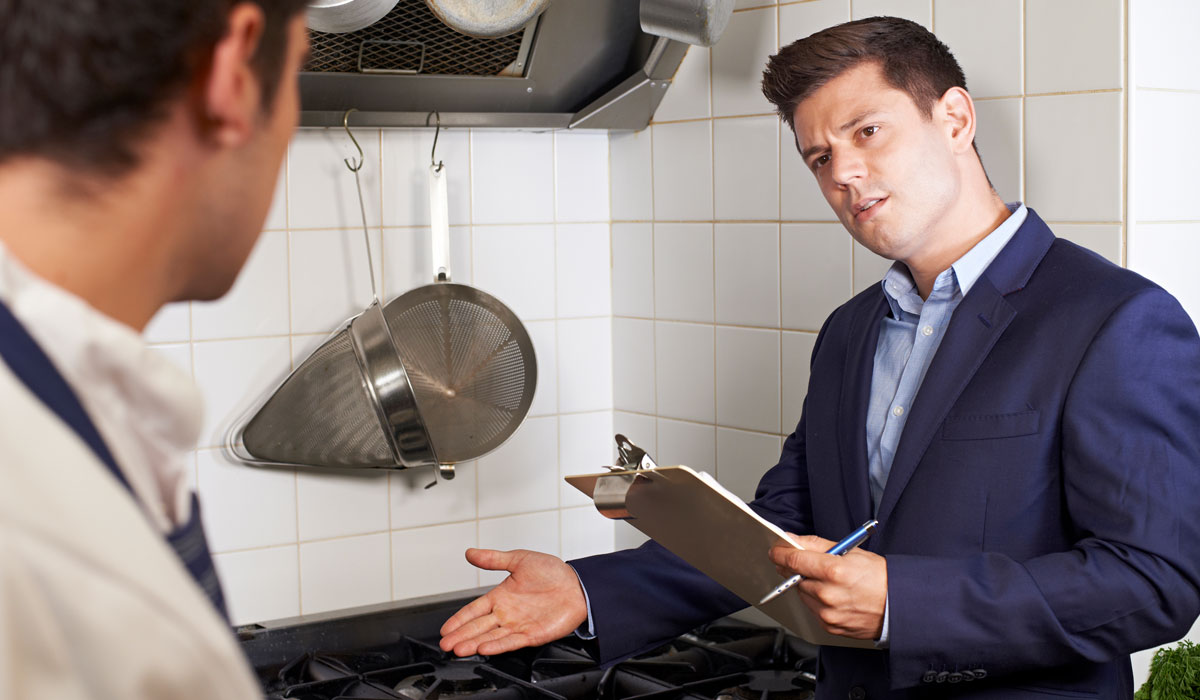Place burgers, flip, remove burgers, clean the grill.
Place burgers, flip, remove burgers, clean the grill.
Place burgers, slip, now there’s a workers’ comp claim.
It’s easy to see how the mechanization and high pace of modern-day quick-service restaurants can lead to greater efficiencies, but shortcuts with safety should never be taken. In addition to securing the recommended business insurance policies, restaurants should always implement and follow best practices for safety to avoid costly accidents altogether.
One in 20 on-the-job injuries and illnesses worldwide occur at eating and drinking establishments, according to a study by Cintas Corporation. For every $1 spent on safety programs, businesses can save $4–6 from costs associated with injuries and fatalities. Not only are safety programs a way to protect employees and the general public, they just make financial sense for savvy restaurant owners and supervisors.
Go to the restaurant experts
The first step in protecting a quick-service restaurant from the consequences of accidents is for owners to work with a restaurant-dedicated insurance company to ensure they have the appropriate insurance for their industry and geography. Placing insurance with a direct, as opposed to traditional, insurance provider can save time and money—as much as 15–20 percent on average—over traditional insurance providers.
Unlike traditional agents, restaurant-dedicated insurance companies understand the unique risks quick-service restaurants are exposed to and have coverages appropriate for their industry and location. They know to consider risks like delivery, alcohol, and general kitchen hazards. They look at likely natural disasters that could affect the building and loss of business. Finally, they meet or exceed unique coverage needs by providing policies that fulfill franchise systems’ FDD requirements, as they are closely familiar with those obligations.
Safety first
Once tailored restaurant insurance is purchased, owners should direct their attention to safety practices. While dangers exist almost everywhere, many quick-serves have three common risk exposures: auto accidents involving delivery drivers; customer slip, trips and falls and workers’ compensation claims.
Delivery Dos and Don’ts
A relatively inexperienced workforce operating at a fast pace leads to many on-the-job safety risks, especially when behind the wheel as a delivery driver. Be thorough when selecting drivers and consider the following checklist:
- Review Motor Vehicle Records (MVRs) to ensure they meet your insurance company’s standards.
- Require a minimum of two years’ driving experience.
- Request a valid certificate of insurance for their automobile.
- Inspect the driver’s vehicle with a safety and appearance checklist.
- Establish a formal cell phone use policy, like the one recommended by the National Safety Council.
Customer slips, trips, and falls
Slips, trips, and falls are the second-leading cause of injury, after auto accidents. The most common causes are liquids on walking surfaces, debris and objects on floors and weather conditions. Use this checklist to prevent it from happening in a store:
- Identify and clean spills and items on the floor, both inside and outside the restaurant.
- Use wet floor caution signs to alert customers of hazards on the floor.
- Place nonslip mats or rugs in areas that may get wet, like self-serve beverage areas.
- Keep walkways and work areas free of clutter.
- Slow down and stay alert to possible slip, trip and fall hazards.
- Don’t carry view-obstructing objects.
Protecting workers
With the high speed and repetition of work, it’s easy to see why the restaurant industry accounts for 5 percent of all workplace accidents. Consider the following tips to reduce, or even eliminate, workplace disasters:
- Work with managers and employees to identify hazards in the kitchen and dining rooms. Create a plan to mitigate their dangers.
- Encourage employees to familiarize themselves with basic first aid skills and keep a stocked first aid kit accessible to all employees.
- Place rubber mats near sinks, stoves and dishwashers to prevent employee slips, trips and falls.
- Emphasize proper lifting techniques to prevent painful neck, back and shoulder strains.
- Keep knives sharp, require use of cut resistant mesh gloves and teach proper slicing techniques to prevent cuts and lacerations.
Ultimately, obtaining insurance from a restaurant-dedicated company is the best way to protect your investment. Selecting a direct insurance provider offers peace of mind and premium savings—often 15–20 percent, on average. That combined with maintaining a strict focus on safety practices can prevent expensive accidents from taking place and will lessen the financial impact if they do.












